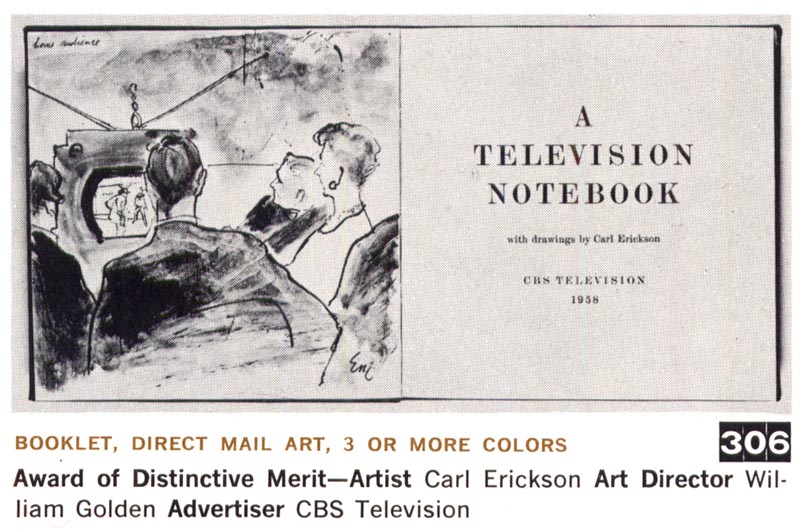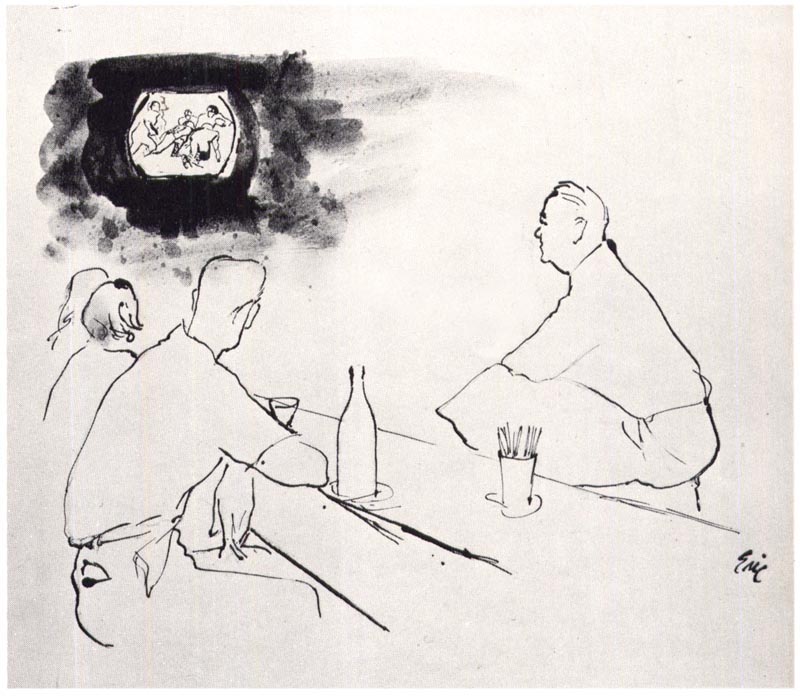
In 1917 Carl Erickson was working in New York as an advertising illustrator, a career he had pursued in Chicago until 1914.
The idea of Erickson working in advertising brings me to an excellent comment left on yesterday's post from Melanie Reim, the Chair of the MA in Illustration program in the School of Graduate Studies at the Fashion Institute of Technology, that bears further examination. Melanie wrote, "rarely is there a class in gestural figure drawing, fashion illustration, nor documentary art at the Fashion Institute of Technology, where I teach, that the likes of Eric, Rene or Jack Potter are not mentioned, amongst other fashion/lifestyle greats. The knowledge and foundation of their understanding of the figure resonates under the deceptively simple line."

Melanie's reference to "lifestyle" illustration really made me stop and think...
As someone who has only ever given fashion illustration a passing glance, I had never thought of fashion artists like Eric as lifestyle illustrators. This, to me, is the realm of the advertising artist... but Melanie is absolutely correct -- its because artists like Eric were such keen observers of the form and so adept at translating the figure into "deceptively simple line" that their work is so remarkable - and so well suited for interpreting lifestyle.

Several people have commented to me privately this week that they don't really 'get' fashion illustration (and I'll bet there are many more). But consider that some others with whom we may be far more familiar (and perhaps relate more directly to) similarly embraced the philosophy of keen observation and a "deceptively simple line"...
Was Eric an influence on such artists as Austin Briggs as well?

All of this brings us to what I think is a rather remarkable circumstance.
Carl Erickson died in 1958. That year he received an Award of Distinctive Merit from the New York Art Director's Club for his work on a direct mail pamphlet for CBS Television.

I find it not a little ironic that the artist who spent a lifetime portraying the elegance and sophistication of the fashion world in the pages of Vogue received, as his final honour, recognition for his interpretation of a lifestyle as mundane as the act of watching television.
Here we see no "chic femininity" -- just the backs of people's heads as they stare, transfixed by the "boob tube".

As we know, television would soon choke the life out of the magazine industry upon which illustrators of all types relied for their livelihood
There's an almost allegorical quality in the passing of Carl Erickson, the epitome of the illustrator of an earlier time, portraying, through his sophisticated style, the rise of America's new most popular medium.
* My thanks to Tom Whitmore for sharing his beautiful Eric original and to Melanie Reim for helping us to better understand the importance of the work of Carl Erickson. * Please note that there is a permanent link in the sidebar for those interested in further exploring the Fashion Institute of Technology's website.
* My Eric Flickr set.
I wish I could find a copy of that CBS notebook. I know that CBS hired a different artist to do one each year. Robert Weaver, Rene Bouche, and Feliks Topolski all did one.
ReplyDeleteHere we see no "chic femininity" -- just the backs of people's heads as they stare, transfixed by the "boob tube".
ReplyDeleteWhat's the most significant feature about this illustration, is just how distinctively simple it is in expressing the other worldliness of the television medium, and how as you've noted these people in the real world are transfixed by those shown in this other world. As if their real world was either too boring to truly enjoy or wasn't good enough to be giving it all of their attention. Their minds are now easily captivated and trapped by this all pervasive new medium called Television.
Very well put, Anonymous, it certainly make one think, doesn't it. Here, captured with great acuity by Eric, is - not just a moment in time - but an historic moment: the death of conversation and camaradarie and the beginning of the long, slow slide into technological self-indulgence. The setting being a bar or pub - an ageless symbol of a p-lace of convesation and companionship - makes the moment all the more poignant.
ReplyDeleteI adore the first sketch - the amount of personality is delightful.
ReplyDeleteI am also intrigued by the dialogue in the comments regarding the last picture - I sometimes feel like there are days when I haven't had a single conversation with a 3D person! Real (2 sided) conversation is quickly becoming a "lost art".
Thanks so much for posting this Leif! I think another strong influence on Carl Erickson, and probably everyone in his early circle, is Toulouse-Lautrec. Anyone agree, disagree? I see it in the staging, line quality, and color choices, I think.
ReplyDeleteI guess Francis Marshall should be included in this discussion also...
I really think Noel Sickles was influenced by Marshall - hope this link works: Marshall
Scroll down to Marshall's books. Wow.
I was wondering when someone was going to get around to mentioning Francis Marshall.
ReplyDeleteHis "An Englishman in New York" is a classic of deceptively simple line that portrays a wealth of personality.
He's the epitome of the statement that if photography shows us how we looked, illustration shows us how we perceived ourselves.
I'm pretty sure the Lautrec influence has been brought up before. I don't have it in front of me but the page on Eric in Walt Reeds book "Great American Illustrators" makes mention of it.
ReplyDeleteJosh; Thanks for the link to Stuart Ng's books on Francis Marshall. I was unfamiliar with the British illustrator until the other day but I can see now that we will have to get into looking at his work and career some time soon. Those books look absolutely mouth-water!
ReplyDeleteRodge; Why wait until someone else mentions marshall? I'm counting on you to jump in and educate me at the earliest opportunity, buddy! ;^)
Daniel; My "Illustrator in America" edition (2000) doesn't mention Eric's influences, but yes, someone did mention Lautrec in an earlier comment. Sargent has come up as well in regard to the New York cabby drawing. I have a lot to learn!
krystyna81; so true! I feel the same way, now that I work at home... miss the days of sharing a studio w/ 5 other illustrators and the constant stream of visitors. Twitter's fun, but some days the only person I actually talk to is the dog! ;^)
ReplyDeleteSomeone may have already mentioned this and I missed it, but just saw this upcoming exhibit at Society of Illustrators in NYC, for those who can make it.
ReplyDeletehttp://societyillustrators.org/museum/line_of_fashion.cms
I just found out that next month the Society of Illustrators is having a show featuring the work of fashion artists.
ReplyDeleteHere's a link:
http://societyillustrators.org/museum/line_of_fashion.cms
Haha...Laurie it looks like we posted at the exact same time!
ReplyDeleteLeif...I don't have it infront of me but doesn't one of the pages I emailed you yesterday mention Lautrec? I can't remember where that page came from but I think it's one of Walt Reeds books.
"The death of conversation and camaradarie..." as Leif so eloquently puts it.
ReplyDeleteHow Carl Erickson caught those television scenes, with his "deceptively simple lines". Wow!
Just remembered a marriage counselor I once heard on the radio talking.
He said when dealing with a couple estranged, with hardly anything to talk about and communicate, his first question would be: "How many hours a day is your TV on?"
Thank you for your beautiful work of research! It's really precious!
ReplyDeleteLeif, I'm so delighted you featured Eric.
ReplyDeleteAs a fashion illustrator myself, I am naturally a little touchy about people not "getting" fashion illustration. What, as they say, is not to get? The great fashion artists, Eric, Bouche, Keogh, Blossac, Willaumez and of course Gruau were artists first and foremost; artists whose subject was fashion.
And isn't fashion as legitimate a subject for art as any other?
Eric in fact changed the whole medium. In the teens and twenties fashion illustrators like Barbier, Lepape and Marty created stylized worlds, concentrating on pattern, colour and surface design, setting their characters against theatrical backdrops and in many ways defining the whole notion of 'art deco'.
Eric, who married to a Vogue staff illustrator, Lee Creelman, in the 20s, had been freelancing and working on advertising accounts since around 1912. He began working for Vogue in the mid twenties, and his first cover for the magazine in 1932 effectively changed the way fashion illustration looked. Eric dispensed with artifice. He drew what he saw (it is said that if he was drawing a model in an ill-fitting dress, that's the way he showed it) and more than anyone before him he embraced the properties of line. His drawings, with their effortless fluidity and unerring eye, described a world of privilege; the gala, the ball and trips to the Riviera in a way that was both idealised and true. Eric was Vogue's longest serving 'star' illustrator and, in the days before the total dominance of photography in fashion magazines, that meant something; suites at the Dorchester or the Ritz, first class travel, suits from Savile Row tailors charged to the magazine.... a different world, indeed.
In terms of his influence, it extended beyond his rivals at Vogue, Bouche and Willaumez, to artists of the high Deco period like Benito whose work began to take on a distinctly 'Eric' caste.
All sketches are stunning. Especially the first one. It is very good and the color is style looking good even if it is damaged. Taking care of those gorgeous sketches is hard. I just hope it last for more decades.
ReplyDeleteHave you read this https://resumecvwriter.com/blog/cv-vs-resume? You'd better should!
ReplyDelete